IOS Felicitates Prof. (Dr) Seyed E. Hasnain
December 5, 2015 at the CIT Auditorium at Jamia Millia Islamia, New Delhi
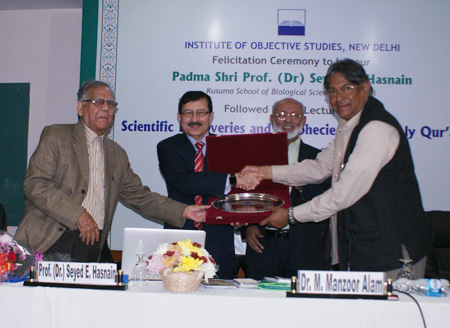
Padma Shri Prof. (Dr) Seyed E Hasnain of the Biological Sciences, Indian Institute of Technology (IIT), Delhi, was felicitated by the Institute of Objective Studies at an impressive ceremony at the CIT Auditorium at Jamia Millia Islamia here on December 5, 2015 for his exceptional contribution to molecular biology and epidemiology of mycobacterium tuberculosis. Speaking on “Scientific Discoveries and Prophecies in the Holy Quran”, on the occasion, Dr. Hasnain noted that Allah revealed Quran to Prophet Mohammad (SW) 1400 years ago to guide humanity, but not a single word had been added to or subtracted from it afterwards. The predictions made in the Quran had been proved true by science. He said that ever since the Quran was revealed, it had possessed countless scientific, mathematical and historical miracles. “The divine knowledge is contained in the “Mother of Books (Ummul Kitab)” and the “Tablet Preserved (Lauh-i-Mahfooz)”, he said. He observed that many of the verses revealed in the Quran had only been recently discovered by science and the use of modern technology. Explaining the relationship of science with religion, he quoted the theoretical physicist and Nobel laureate, Albert Einstein who had said, “Science without religion is lame, religion without science is blind.”
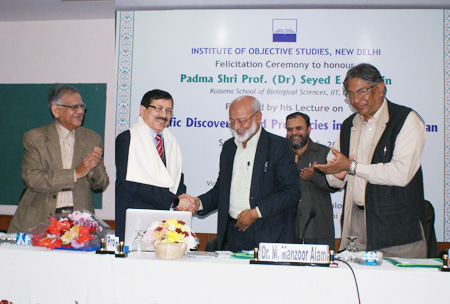
Dividing the world in which we live today into physical and bio worlds, Dr. Hasnain held that both of them were inter-connected and impacted each other. Referring to the creation of the universe, he said that there was the striking congruence between the Quranic verse (21.30) and the Big Bang was inescapable. According to the Big Bang, the universe was initially one big mass (primary nebula). Then there was a Big Bang (secondary separation) which resulted in the formation of galaxies. He observed that the origin of the universe was unique and the probability of it occurring by chance was zero. Regarding the alternation of day and might, he said that the Quran spoke of the merger of night into day and vice-versa. This phenomenon could only take place if the earth was spherical. If it was flat, there would have been a sudden change from night to day and from day to night, he noted. In regard to the shape of the earth, he again quoted the Quran as saying that the earth was egg-shaped. The Arabic word for egg described meant an ostrich egg. The shape of an ostrich egg resembled the geo-spherical shape of the earth. Thus the Quran correctly described the shape of the earth, though the prevalent notion when the Quran was revealed was that the earth was flat, he said. Commenting on light, he said that according science, the light of the moon was reflected light. However, this fact was mentioned in the Quran 1400 years ago. In the 20th century, modern science proved that the ozone surrounding the earth played an important role in protecting earth from ultraviolet causing destruction of living beings. This was already revealed by the Quran (21:32).
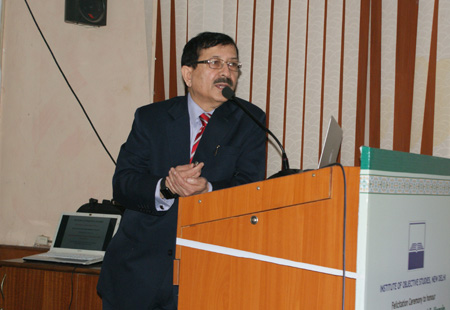
Referring to the barrier between sweet and salt waters, Prof. Hasnain observed that early commentators of the Quran were unable to explain the two opposite meanings for the two bodies of water, i.e., they met and mixed, and at the same time, there was a barrier between them. Modern science had discovered that in the places where two different seas met there was a barrier between them. This barrier divided the two seas, so that each sea had its own temperature, salinity and density, he said quoting oceanography by Davis. He noted that this scientific phenomenon mentioned in the Quran was also confirmed by Dr. William Hay who was a well-known marine scientist. When the Quran spoke about the divider between fresh and salt water, it mentioned the existence of a “forbidding partition” with the barrier.
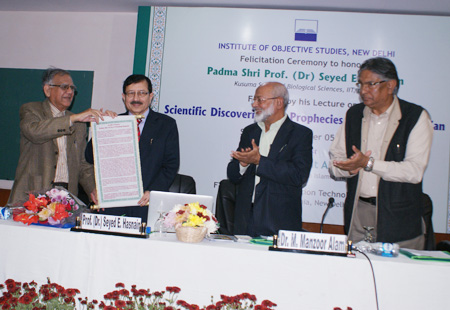
He said that this phenomenon occurred in several places, including Egypt, where the river Nile flowed into the Mediterranean Sea. Referring to the mention of “fruit of every kind in pairs” in the Quran, he said once pollen had been carried to the flower, they bore fruit, which in turn matured and freed its seed. All fruits therefore implied the existence of male and female trees. Similarly, a couple of centuries ago man came to know that honey came from the belly of the bee. But the Quran had prophesied it centuries ago.
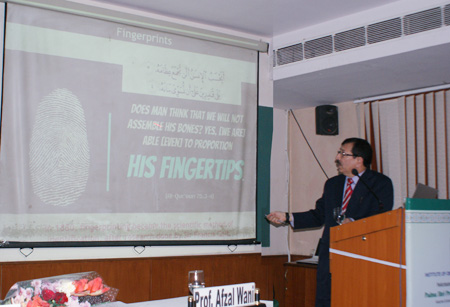
Dr. Hasnain remarked that the fingertips created by Allah differed from man to man. There were no identical fingertips among human beings. In 1880, fingerprinting became the scientific method of identification, after research done by Sir Francis Golt. Explaining the importance of DNA, he said that the DNA of every human being on the planet was 99.9 percent the same adding that it was the 0.1 percent that made all the difference. The Quran’s reference to the development of embryo in three stages was confirmed by Prof. Keiths Moore. These were known as three layers of darkness. Defining the micro biota, he said that micro biota was “the ecological community of commensal, symbiotic and pathogenic micro-organisms that literally shared our body space. Underlining the importance of micro biota, he said that it had a role in the treatment of diseases like diabetes, asthma, rheumatoid arthritis, muscular dystrophy, multiple sclerosis, fibromyalgia, cancer, obesity, depression, etc. He said that living organism was a natural computer with hardware and software. Elaborating further, he said that when one died, the hardware remained, but software was deleted.
Prof. Hasnain noted that there were more than six thousand signs in the Quran of which more than a thousand dealt with science. A totally objective examination of the Quran in the light of modern knowledge led us to recognise that the divine knowledge was contained in the “Mother of Books” and the “Tablet Preserved”, he concluded.
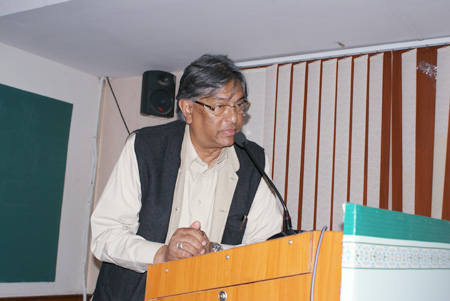
Vice-Chancellor of Jamia Millia Islamia, Prof. Talat Ahmad, who was the chief guest of the function, in his speech described Prof. Hasnain’s talk as illustrative, inspiring and full of knowledge. Holding that the Quran encouraged the ummah to undertake research in different fields, he said that this opened up far more possibilities of acquiring knowledge. Laying stress on the need for discovering similarities between the Quranic prophesies and the findings of science, he assured of JMI’s help in such projects of the IOS. While ruling out any possibility of a Centre for Research on the Quran and Science as suggested by Prof. M. Afzal Wani of Guru Gobind Singh Indraprastha University he informed that the Department of Islamic Studies was already in place in the JMI. He reiterated his commitment for support and assistance to any collaborative research on the Quran and science to be initiated by any institution.
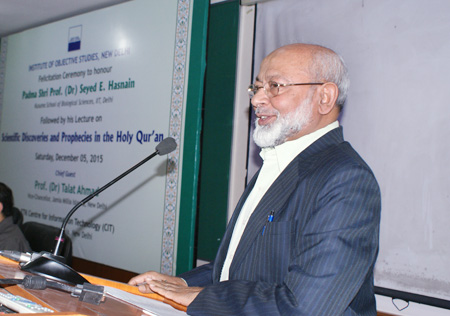
In his presidential remarks, the Chairman of the IOS, Dr. M. Manzoor Alam insisted that guidance and wisdom was not the exclusive preserve of a particular community. We could never claim to be above mistake and many mistakes would occur in our lifetime. Briefly outlining the IOS quest for research in various fields of human activity, he informed that the Institute was gearing up for its 30th anniversary celebrations in 2016. Referring to Lauh-i-Mahfooz, he said that Allah sent Adam to the earth as His prophet and preserved the holy Quran which was later revealed to prophet Mohammad (SW). That conclusively proved that the Arabic language was the most ancient language of the world. On this occasion, he announced the setting up of a forum for Quran and Science by the IOS.
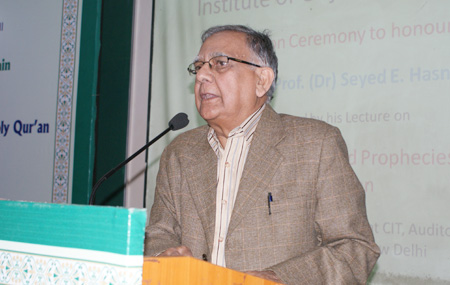
In his welcome address, the Secretary General, IOS, Prof. ZM Khan, said that against the backdrop of today’s crisis-ridden world, the message of the Quran was needed the most. He observed that the theme bothered every one of us in one way or the other. The real problem lay in the intricacies of the work as the whole humanity was covered by it. He stressed the need for following the Quran’s teaching and spreading its message throughout the world.
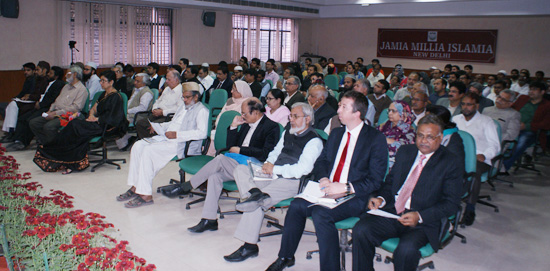
Earlier, a citation highlighting Prof. Hasnain’s achievements was read out by S.M. Shafiq. While Prof. ZM Khan presented the scroll of honour to Prof. Hasnain, Dr. M. Manzoor Alam presented him with a shawl. Prof. Dr. Talat Ahmad presented the memento. The function began with the recitation of a verse from the Quran by Hafiz Athar Husain Nadwi. Prof. M. Afzal Wani conducted the proceedings and a vote of thanks was proposed by Professor of Law, JMI, Prof. Eqbal Husain.
PPT of (Dr) Seyed E. Hasnain...
Go Back